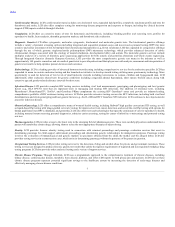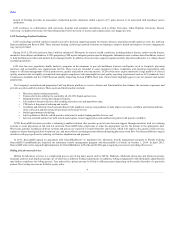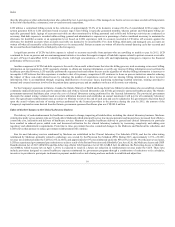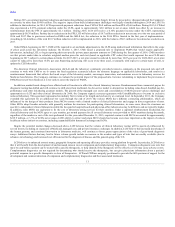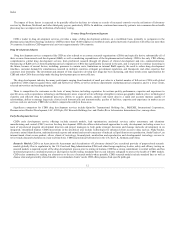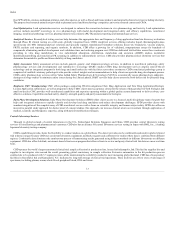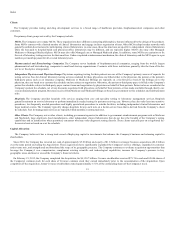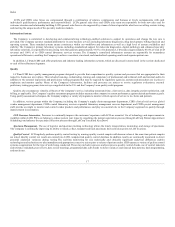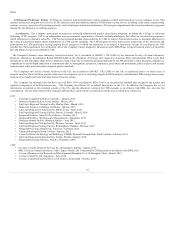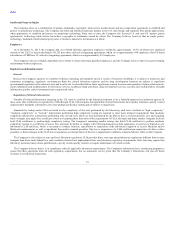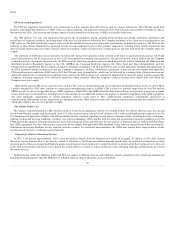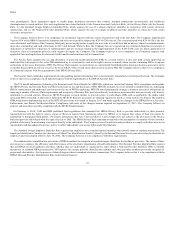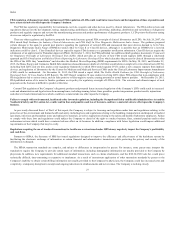LabCorp 2015 Annual Report Download - page 17
Download and view the complete annual report
Please find page 17 of the 2015 LabCorp annual report below. You can navigate through the pages in the report by either clicking on the pages listed below, or by using the keyword search tool below to find specific information within the annual report.
Index
LCD's and CDD’s sales forces are compensated through a combination of salaries, commissions and bonuses at levels commensurate with each
individual’s qualifications, performance and responsibilities. LCD's general sales force and CDD's sales team are responsible for both new sales and for
customer retention and relationship building. LCD's general sales force is also supported by a team of clinical specialists who focus on selling esoteric testing
and meeting the unique needs of the specialty medicine markets.
The Company is committed to developing and commercializing technology-enabled solutions to support its operations and change the way care is
provided. The Company operates standard platforms for its core business services including laboratory diagnostics, drug development, billing, financial and
reporting systems. These standard systems ensure consistency within our workflows and information as well as a high level of system availability and
stability. The Company’s primary laboratory systems, including standardized support for molecular diagnostics, digital pathology and enhanced specialty
laboratory solutions, is responsible for processing tests that generate approximately 93.6% of its domestic LCD revenue (approximately 88.4% of total LCD
revenue) and 100% of its CDD central laboratory services revenue. The Company's centralized information systems are responsible for tremendous
operational efficiencies, enabling the Company to achieve consistent, structured, and standardized operating results and superior patient care.
In addition, LCD and CDD each offer proprietary and industry-leading information systems, which are discussed in more detail in the sections dedicated
to each of those Business Segments.
LCD and CDD have quality management programs designed to provide that comprehensive quality systems and processes that are appropriate for their
respective businesses are in place. This includes licensing, credentialing, training and competency of professional and technical staff, and internal audits. In
addition to the external inspections and proficiency testing programs that may be required by regulatory agencies, systems and procedures are in place to
emphasize and monitor quality. Many of the Company’s laboratories, facilities and processes are subject to on-site regulatory evaluations, external
proficiency testing programs, state surveys as applicable in the U.S. and the Company's own quality audit programs.
Quality also encompasses virtually all facets of the Company’s service, including turnaround time, client service, data integrity, patient satisfaction, and
billing, as applicable. The Company’s quality assessment program includes measures that compare its current performance against desired performance goals.
Using quality assessment techniques, the Company employs a variety of programs to monitor critical aspects of service to its clients and patients.
In addition, various groups within the Company, including the Company's supply chain management department, CDD's clinical trial services global
vendor management department, CDD's central laboratory services expanded laboratory management services department, and CDD's project management
staff, provide oversight to monitor and control vendor products and performance, and play an essential role in the Company’s approach to quality through
improvements in automation.
Processes to continually improve the customers’ experience with LCD are essential. Use of technology and improvements in
workflow within LCD's PSCs are helping to reduce patient wait times by expediting the patient registration process (through LabCorp Patient Appointment
Scheduling) and enhance the specimen collection process (through LabCorp Touch and AccuDraw).
The use of logistics and specimen tracking technology allows the timely transportation, monitoring, and storage of specimens.
The Company is continually improving its ability to timely collect, transport and track specimens from collection points to LCD locations.
LCD regularly performs quality control testing by running quality control samples with known values at the same time patient samples
are tested. Quality control test results are entered into LCD's computerized quality control database. In addition, results are continually monitored to detect
potential analytical variances during testing. The real-time monitoring for any statistically and clinically significant analytical differences enables
technologists and technicians to take immediate and appropriate corrective action prior to release of patient results. CDD operates a variety of quality control
systems as appropriate for the type of work being conducted. These may include in-process and post-process quality control checks, use of control materials
and reference standards, peer reviews, data review meetings, programmed data edit checks to detect variances and unusual data patterns, dual programming,
and mock runs.
17


